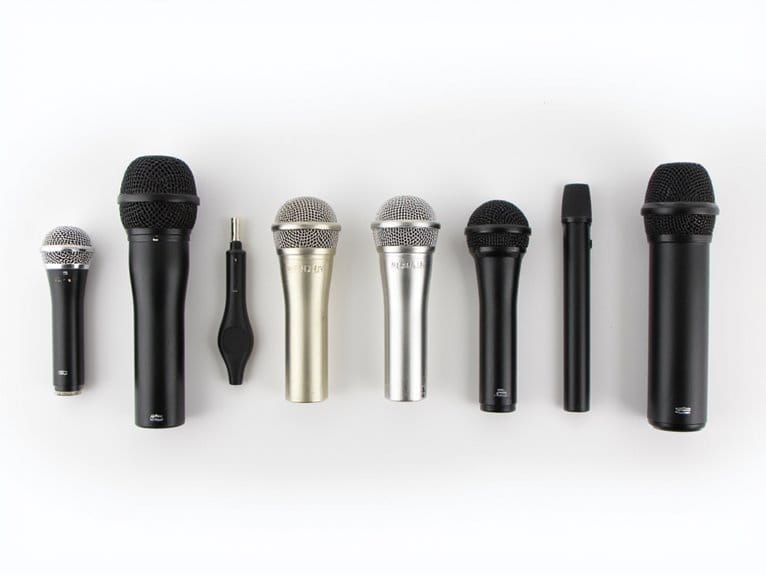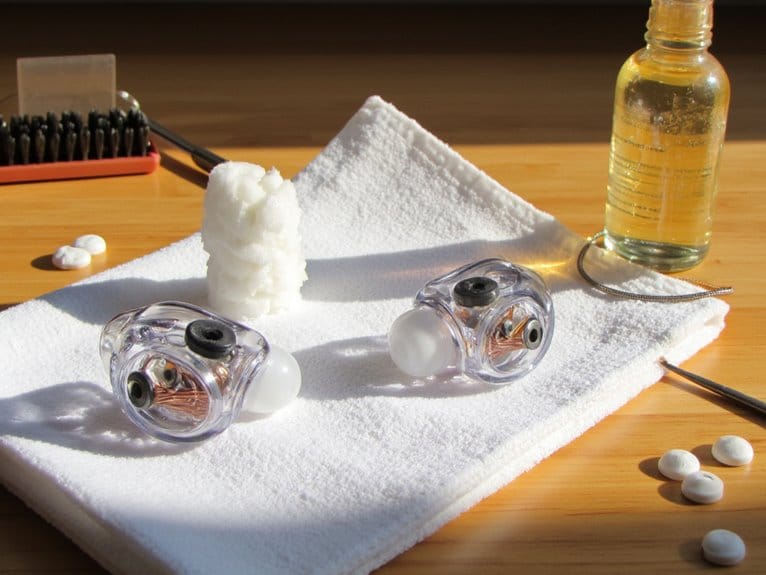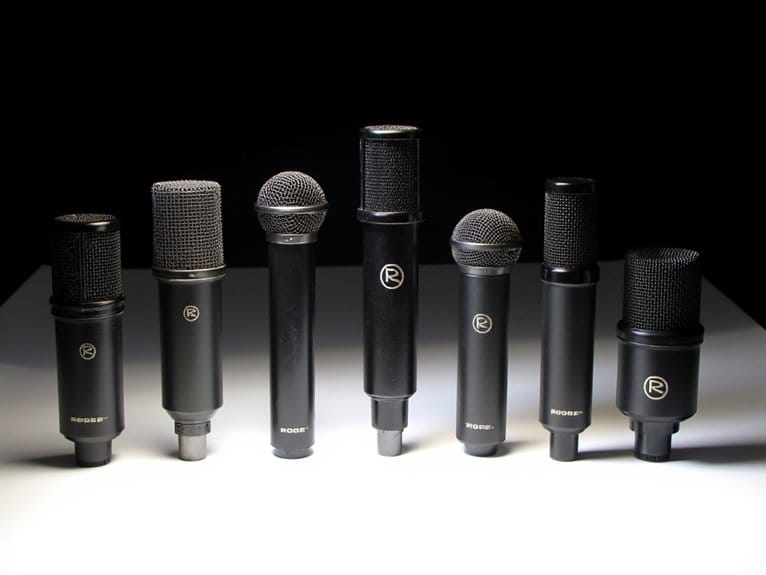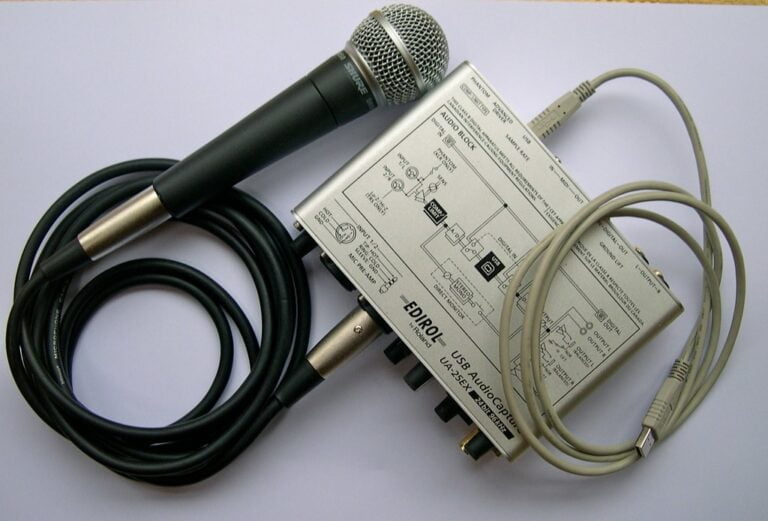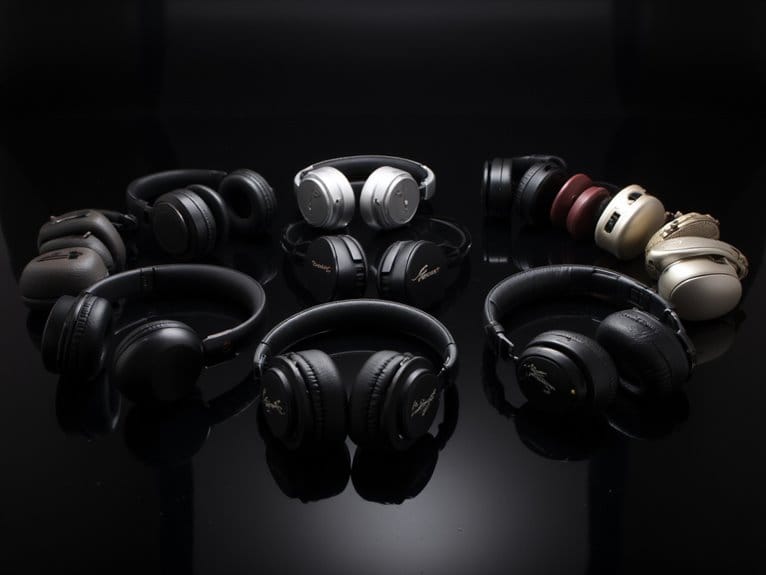Best On-Camera Microphones for Crystal Clear Audio
After testing dozens of microphones, I’ve found the RØDE VideoMic GO II Helix and GODOX WEC Wireless Lavalier deliver exceptional audio quality for their price points, while the Movo VXR10 offers reliable shotgun performance across multiple devices. These models feature superior noise reduction, battery-free operation, and professional-grade frequency response that transforms amateur footage into polished content. Each excels in specific scenarios, and understanding their unique strengths will help you choose the perfect microphone for your creative projects.
We are supported by our audience. When you purchase through links on our site, we may earn an affiliate commission, at no extra cost for you. Learn more.
Notable Insights
- Shotgun microphones like RØDE VideoMic GO II offer directional audio capture with universal compatibility across smartphones, DSLRs, and tablets.
- Wireless lavalier microphones provide hands-free recording with 200-meter range and 8-24 hour battery life for interviews and presentations.
- Battery-free designs eliminate power management hassles while delivering professional-grade sound with high signal-to-noise ratios up to 74dB.
- Shock mounts and isolation systems reduce handling noise and vibrations, ensuring crystal clear audio during handheld filming scenarios.
- Frequency response ranges of 20 Hz to 20 kHz with noise reduction technology enhance audio quality in challenging recording environments.
Movo VXR10 Universal Shotgun Mic for Camera and Smartphones

The Movo VXR10 Universal Shotgun Mic stands out as an exceptional choice for content creators who demand professional audio quality without breaking the bank, particularly those juggling multiple devices in their creative workflow. You’ll appreciate its remarkable compatibility across smartphones, DSLRs, and tablets, though you’ll need dongles for newer phone models. The durable aluminum construction, integrated shock mount, and included deadcat windscreen demonstrate thoughtful engineering that minimizes handling noise during dynamic shoots. I’ve found its battery-free design eliminates those frustrating dead-battery moments mid-recording. While certain Canon Rebel models remain incompatible, this versatile mic excels at YouTube vlogs, interviews, and outdoor events.
Best For: Content creators who need professional audio quality across multiple devices including smartphones, DSLRs, and tablets for vlogs, interviews, and outdoor recording.
Pros:
- Universal compatibility with smartphones, cameras, and recording devices eliminates need for multiple microphones
- Battery-free design with integrated shock mount and included windscreen provides reliable performance without power concerns
- Durable aluminum construction offers professional build quality at an affordable price point
Cons:
- Requires additional dongles for newer smartphone models with lightning or USB-C ports
- Not compatible with certain Canon Rebel models (T5, T6, T7 without i suffix)
- Limited to devices with 3.5mm external microphone inputs, restricting some camera compatibility
GODOX WEC Wireless Lavalier Microphone for Camera Computer Smartphone

Content creators who demand professional audio quality without breaking the bank will find their perfect match in the GODOX WEC Wireless Lavalier Microphone, a remarkably compact system that weighs just 12 grams for the transmitter and delivers exceptional performance across cameras, computers, and smartphones. You’ll appreciate the 200-meter wireless range that maintains crystal-clear audio quality, while the dynamic noise reduction technology eliminates distracting background sounds during outdoor shoots or busy environments. The 8-hour battery life extends to 24 hours with the charging case, and the built-in digital display keeps you informed about remaining power, preventing those awkward moments when your audio cuts out mid-interview unexpectedly.
Best For: Content creators, vloggers, and professionals who need reliable wireless audio recording for interviews, live streaming, and outdoor shooting across multiple devices including cameras, computers, and smartphones.
Pros:
- Ultra-lightweight design at just 12g transmitter weight with impressive 200-meter wireless range
- Extended battery life of 8 hours (24 hours with charging case) and built-in digital battery display
- Exceptional audio quality with lossless reproduction, dynamic noise reduction, and adjustable ±6dB gain control
Cons:
- Limited to basic lavalier microphone functionality without advanced features like multiple channel support
- Performance may vary in environments with significant wireless interference despite the 200m advertised range
- Compact size, while portable, may make physical controls more difficult to adjust during use
Movo VXR10 Universal Shotgun Mic for Camera (Compatible with DSLR, iPhone and Android)

Versatility stands as the defining characteristic that makes the Movo VXR10 Universal Shotgun Mic an exceptional choice for creators who work across multiple platforms and devices, from professional DSLR cameras to smartphones. You’ll appreciate its durable aluminum construction that delivers reliable performance without requiring batteries, while the integrated shock mount effectively minimizes handling noise during recording sessions. The included deadcat windscreen proves invaluable for outdoor shoots, though you’ll need appropriate dongles for newer iPhone or Android models with USB-C connections. This microphone excels across diverse scenarios, from YouTube vlogs to live music recordings.
Best For: Content creators who need a versatile microphone that works seamlessly across multiple devices including DSLR cameras, smartphones, and tablets for various recording scenarios from vlogs to outdoor events.
Pros:
- Universal compatibility across smartphones, tablets, cameras, and camcorders with durable aluminum construction
- Battery-free design with integrated shock mount that effectively minimizes handling noise
- Complete package includes deadcat windscreen and carry case, making it ideal for outdoor recording
Cons:
- Requires additional dongles for newer iPhone or Android models with USB-C connections
- Not compatible with certain Canon camera models (Rebel T5, T6, T7 without i suffix)
- May need specific adapters depending on your device’s connection type
RØDE VideoMic GO II Helix Ultra-Compact On-Camera Shotgun Microphone

When I first encountered RØDE’s VideoMic GO II Helix, I immediately recognized its appeal for creators who refuse to compromise between portability and professional audio quality. This ultra-compact shotgun microphone delivers dual connectivity options through its 3.5mm TRS output for cameras and digital USB output for smartphones, tablets, and computers, eliminating the typical cable juggling act I’ve experienced with other mics. The battery-free operation, combined with straightforward plug-and-play functionality, removes those frustrating power management concerns that plague many recording sessions. RØDE’s HELIX isolation mount system, paired with the included windshield, effectively minimizes handling noise, wind interference, and plosives that typically compromise audio quality.
Best For: Content creators, filmmakers, and podcasters who need professional-quality audio recording with maximum portability and versatility across cameras, smartphones, and computers.
Pros:
- Dual connectivity options (3.5mm TRS and USB) eliminate the need for multiple microphones across different devices
- Battery-free operation with plug-and-play simplicity removes power management hassles during recording sessions
- HELIX isolation mount system and included windshield effectively reduce handling noise, wind interference, and plosives
Cons:
- Ultra-compact design may limit audio pickup range compared to larger shotgun microphones
- Advanced features like high-pass filter and frequency adjustments require separate RØDE software installation
- Shotgun microphone pattern may not be ideal for multi-person recordings or wide audio capture scenarios
RØDE VideoMicro II Ultra-Compact On-Camera Shotgun Microphone

The RØDE VideoMicro II stands out as the ideal choice for content creators who need professional audio quality without the bulk, measuring just 80mm in length and weighing a mere 39 grams. You’ll appreciate its highly directional pickup pattern, which captures your subject’s voice clearly while effectively minimizing distracting background noise that can ruin otherwise perfect shots. The innovative Helix isolation mount system protects your recordings from handling noise, bumps, and accidental knocks that inevitably occur during handheld filming sessions. Its built-in shoe mount and integrated cable management system create a clean, organized setup that won’t clutter your camera rig or complicate your workflow during shoots.
Best For: Content creators, videographers, and mobile filmmakers who need professional-quality directional audio recording in an ultra-portable form factor for on-camera use.
Pros:
- Ultra-compact and lightweight design (80mm, 39g) makes it highly portable and unobtrusive on any camera setup
- Highly directional pickup pattern effectively captures subject audio while minimizing background noise
- Innovative Helix isolation mount system provides excellent protection against handling noise and vibrations
Cons:
- Limited to on-camera mounting options due to built-in shoe mount design
- May not provide sufficient audio pickup range for subjects positioned far from the camera
- Lacks advanced features like gain control or built-in wind protection for outdoor filming
Comica CVM-V30 LITE Video Microphone for DSLR Cameras and Smartphones

Content creators who frequently switch between smartphone and DSLR recording will find the Comica CVM-V30 LITE particularly appealing, as it eliminates the perpetual fumbling with TRS and TRRS adapters that I’ve personally found frustrating during fast-paced shoots. The super-cardioid condenser shotgun microphone delivers professional audio capture without requiring batteries, drawing power directly from your device’s 3.5mm jack. Its shock-absorption mount effectively minimizes handling noise that often plagues handheld recording sessions, while the super cardioid polar pattern focuses on your intended audio source while rejecting ambient distractions. The cold-shoe mounting system with quarter-inch threading provides versatile attachment options across various camera configurations.
Best For: Content creators who frequently switch between smartphone and DSLR recording and need a versatile, plug-and-play microphone that delivers professional audio quality without the hassle of multiple adapters or battery management.
Pros:
- Universal compatibility with easy switching between camera and phone modes without needing separate TRS/TRRS adapters
- No battery required – powered directly by device’s plug-in power for unlimited recording time
- Effective noise reduction through shock-absorption mount and super cardioid polar pattern that focuses on intended audio while rejecting ambient noise
Cons:
- Requires devices with 3.5mm mic jack, limiting compatibility with newer smartphones that lack headphone ports
- Plug-in power dependency means unusable with devices that don’t provide sufficient power through the audio jack
- Cold-shoe mounting design may not be compatible with all camera accessories or mounting configurations
Wireless Lavalier Microphone for iPhone/Android/Camera/PC/Laptop – Black
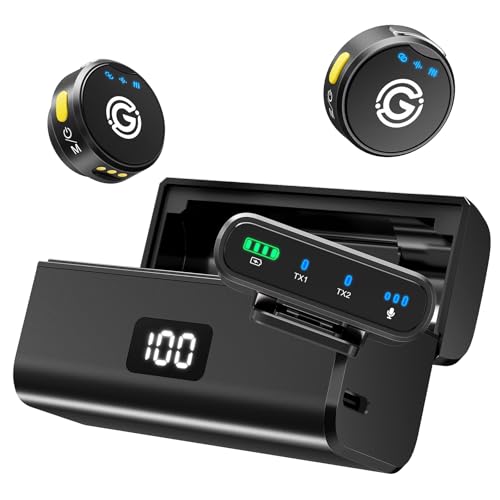
Studio-grade audio quality meets unprecedented portability in this wireless lavalier microphone, making it an ideal choice for content creators, journalists, and anyone who needs professional sound without the bulk of traditional recording equipment. Weighing just 9 grams, this compact microphone delivers impressive 65dB signal-to-noise ratio performance while offering versatile Type-C connectivity across multiple devices. You’ll appreciate the plug-and-play functionality that eliminates Bluetooth pairing headaches, though some iPhone 15 users report occasional compatibility hiccups. The six-hour battery life, extended to 29 hours with the charging case, guarantees you won’t miss critical recordings during extended sessions.
Best For: Content creators, journalists, and anyone needing professional-quality audio recording with maximum portability and cross-device compatibility.
Pros:
- Studio-grade sound quality with 65dB signal-to-noise ratio and effective noise cancellation
- Ultra-lightweight 9-gram design with versatile wearing options including magnetic clips and necklace style
- Plug-and-play functionality with Type-C connectivity across multiple devices without requiring Bluetooth or apps
Cons:
- Occasional compatibility issues reported with iPhone 15 models
- Limited to Type-C connectivity which may not work with older devices lacking this port
- At 9 grams, the lightweight design might feel less durable compared to heavier professional microphones
Rode VideoMic Pro+ Camera-Mount Shotgun Microphone,Black

Professional filmmakers and serious content creators who demand broadcast-quality audio will find the Rode VideoMic Pro+ Camera-Mount Shotgun Microphone delivers the focused sound capture that separates amateur recordings from polished productions. This Australian-built microphone features Rycote Lyre suspension that minimizes handling noise, while digital switching technology reduces post-production work by enhancing signal capture at the source. You’ll appreciate the flexible power options, including rechargeable lithium-ion battery, AA batteries, or micro USB connection, ensuring you won’t miss critical shots due to power failures. The 20 Hz to 20 kHz frequency response and 74 dB signal-to-noise ratio provide broadcast-quality audio that transforms your video production quality.
Best For: Professional filmmakers, serious content creators, vloggers, and videographers who need broadcast-quality audio with focused sound capture and minimal background noise for their camera-mounted recording setup.
Pros:
- Exceptional audio quality with 20 Hz to 20 kHz frequency response and 74 dB signal-to-noise ratio for broadcast-level sound
- Versatile power options including rechargeable lithium-ion battery, AA batteries, and micro USB connection for reliable operation
- Advanced Rycote Lyre suspension system and digital switching technology that minimizes handling noise and reduces post-production work
Cons:
- Complex setup when using with phones rather than dedicated cameras
- Tends to pick up excessive low-end noise in certain recording environments
- Higher price point compared to basic shotgun microphones, though justified by professional-grade features
Factors to Consider When Choosing an On Camera Microphone
When I’m helping someone select the perfect on-camera microphone, I’ve found that five critical factors consistently determine whether you’ll capture professional-quality audio or end up frustrated with your purchase. The microphone type you choose, whether it’s a shotgun, lavalier, or dynamic model, must align perfectly with your specific recording environment, subject distance, and content style, while also maintaining seamless compatibility with your camera, recorder, or mobile device through the correct connector types and impedance matching. I’ll walk you through the essential audio quality features like frequency response and signal-to-noise ratio, power requirements that range from plug-in power to battery operation, and mounting systems that’ll keep your microphone stable and positioned correctly throughout your shoot.
Microphone Type Selection
Selecting the right on-camera microphone requires careful consideration of several key factors that’ll directly impact your audio quality, workflow efficiency, and overall production value. I’ve found that understanding the three primary microphone types helps narrow your options considerably. Shotgun microphones, like the Movo VXR10 and RØDE VideoMic, excel at directional audio capture, focusing on subjects while minimizing background interference. Lavalier microphones, such as the GODOX WEC, offer hands-free operation that’s perfect for interviews and presentations, allowing natural movement without compromising audio quality. Condenser microphones, including the Comica CVM-V30 LITE, deliver superior sensitivity and fidelity across various applications, from vlogging to live events. Your specific use case, whether it’s documentary work, corporate videos, or content creation, should guide your type selection.
Compatibility With Devices
Nothing frustrates me more than discovering a promising microphone doesn’t work with my recording setup, and I’ve learned that compatibility checking prevents costly mistakes that can derail entire productions. I always verify the microphone’s output type matches my device’s input, whether that’s 3.5mm TRS for cameras or USB for smartphones and computers. Some devices require specific connectors like TRRS for smartphones, while others need Lightning or USB-C dongles to function properly. I’ve found certain camera models have restrictions that aren’t immediately obvious, so I test compatibility before committing to any purchase. Universal compatibility features are worth seeking out since they eliminate the need for extra cables or adapters when switching between devices.
Audio Quality Features
After years of testing microphones that promised crystal-clear audio but delivered disappointing results, I’ve learned that understanding specific audio quality features separates professional-grade recordings from amateur attempts. I prioritize signal-to-noise ratio above all else, seeking microphones with 65dB or higher for pristine clarity without background interference. Super cardioid or shotgun pickup patterns become essential when I’m recording in noisy environments, effectively isolating my subject’s voice while rejecting ambient sounds. Dynamic noise reduction technology adds another layer of protection against unwanted audio artifacts. A frequency response range spanning 20 Hz to 20 kHz guarantees I capture every nuance, from deep bass tones to crisp highs, creating rich, detailed recordings that truly represent the original sound source.
Power Requirements Options
When I’m choosing an on-camera microphone, I’ve discovered that power requirements often determine whether my recording session succeeds or fails unexpectedly. Battery-powered models offer exceptional portability and independence from recording devices, though they tend to be bulkier due to power compartments. I’ve learned that plug-in microphones eliminate battery concerns entirely, drawing power directly from cameras or smartphones through their connections.
Wireless microphones typically feature rechargeable internal batteries or charging cases, which I find convenient for extended shoots without constant replacements. However, I always monitor battery life indicators religiously, as some devices provide visual displays for remaining power. The weight and size considerations matter greatly, especially during handheld recording sessions where every ounce counts toward comfort and stability.
Mounting System Design
Beyond power considerations, I’ve found that mounting system design makes or breaks the professional quality of my recordings, since even the best microphone becomes useless if it can’t stay securely positioned or picks up every camera movement as distracting noise. I prioritize shock absorption features like rubberized mounts and suspension systems, which effectively isolate the mic from vibrations that would otherwise contaminate my audio tracks. Compatibility matters tremendously-cold shoe mounts and standard 1/4-inch threaded connections guarantee I can attach the microphone to virtually any camera or accessory without hunting for adapters. Adjustable arms and repositioning mechanisms prove invaluable when I’m shooting at awkward angles or in cramped spaces. Lightweight, compact designs prevent my camera setup from becoming unwieldy during extended recording sessions.
Frequently Asked Questions
How Do I Properly Maintain and Clean My On-Camera Microphone?
I’ll clean your microphone regularly with a soft brush to remove dust, use isopropyl alcohol on a cloth for the body, and store it in a protective case to prevent damage.
What’s the Difference Between XLR and 3.5mm Microphone Connections?
I’ll explain the key differences between these connections. XLR provides professional-grade balanced audio with superior signal quality and longer cable runs, while 3.5mm offers convenient plug-and-play connectivity for consumer cameras and devices.
Can I Use Multiple Microphones Simultaneously With One Camera?
I can use multiple microphones with one camera through audio mixers, multi-input recorders, or cameras with dual XLR inputs. I’ll need compatible adapters or splitters for single-input cameras to achieve this setup.
How Do Wind and Weather Conditions Affect Microphone Performance?
Wind creates noise interference that’ll ruin your audio, while humidity can damage sensitive components. I recommend using windscreens, dead cats, or boom poles to shield mics from harsh weather conditions during outdoor recording sessions.
What Microphone Settings Work Best for Different Recording Environments?
I adjust my microphone gain lower in quiet studios to prevent noise amplification, increase it outdoors for stronger signal capture, and use directional pickup patterns in noisy environments while switching to omnidirectional in controlled spaces.
On a final note
After testing these microphones extensively, I’ve found that your choice ultimately depends on your specific filming needs, budget constraints, and technical requirements. Whether you’re capturing wedding ceremonies, conducting interviews, or creating YouTube content, each microphone offers distinct advantages in build quality, frequency response, and directional pickup patterns. I recommend prioritizing features that align with your most common recording scenarios, ensuring ideal audio performance for your particular applications.



